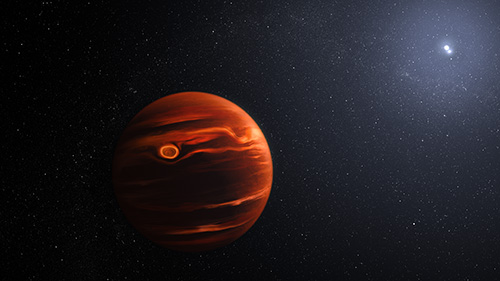Groundbreaking observations of exoplanets from the James Webb Space Telescope (JWST) continue to emerge with the publication of the highest quality, most detailed spectrum ever obtained for a planetary-mass object outside our solar system.
The object (called VHS 1256b) is a brown dwarf—a substellar object that is like a gas giant planet in most respects. The spectrum, which separates the light from the object into its component wavelengths, provides a wealth of information, including evidence of a dynamic atmosphere with clouds of silicate crystals (like hot sand condensing in the atmosphere). A paper on the new findings has been accepted for publication in Astrophysical Journal Letters.
“The richness of information in the spectrum is amazing—there’s never been a spectrum of an exoplanet like this before,” said coauthor Andrew Skemer, professor of astronomy and astrophysics at UC Santa Cruz.
First author Brittany Miles worked on the study with Skemer as a UCSC graduate student and is now a postdoctoral fellow at the University of Arizona. Skemer is a co-principal investigator of the JWST Early Release Science (ERS) program for direct observations of exoplanetary systems. His team at UCSC has led the first two papers from the program, reporting JWST’s first direct image of an exoplanet in September and now its first direct spectrum of a planetary-mass object.
The planet is about 40 light-years away and orbits two stars over a 10,000-year period. “VHS 1256 b is about four times farther from its stars than Pluto is from our sun, which makes it a great target for Webb,” Miles said. “That means the planet’s light is not mixed with light from its stars.”
Skemer explained that the main goal of the ERS programs is to test out the telescope’s instruments in all their observing modes and demonstrate their technical capabilities. The team chose VHS 1256b for the first direct spectrum because it is widely separated from its companions and is known to be similar to other gas giant exoplanets.
“In the ERS program, we’re learning how to use the telescope to do science, but of course we’re seeing new things while we’re doing that, and that’s especially the case with this spectrum,” he said. “There are so many features in the spectrum, it allows us to probe different depths of the atmosphere and really see a full picture of the planet.”
The spectrum was obtained using two spectrographic instruments, NIRSpec and MIRI, which combined to provide extremely precise measurements over a very broad range of infrared wavelengths (from 1 to 20 microns). The features observed in VHS 1256b’s atmosphere include water, methane, carbon monoxide, carbon dioxide, sodium, and potassium.
The methane features are not as strong as expected compared to similar objects, which Skemer said is the result of vigorous mixing of the atmosphere and chemical reactions leading to depletion of methane.
“It’s a highly dynamic atmosphere, with strong upwelling of hot gases, which are also condensing to form these silicate clouds,” he said.
According to Miles, the team has only begun to explore all the information contained in the spectrum. “We’ve identified silicates, but better understanding which grain sizes and shapes match specific types of clouds is going to take a lot of additional work,” Miles said. “This is not the final word on this planet—it is the beginning of a large-scale modeling effort to fit Webb’s complex data.”
Previous ground-based observations had indicated that the luminosity of VHS 1256b is highly variable, increasing and decreasing in brightness by as much as 25 percent. Skemer said this variability is related to the silicate clouds and atmospheric turbulence.
VHS 1256b is relatively young (less than 300 million years), and its wide separation from its companion suggests that it did not form like a typical exoplanet. The spectroscopic analysis confirmed that its mass is less than 20 times that of Jupiter, but the researchers could not determine if it is above or below the mass often used as a dividing line between exoplanets and brown dwarfs (about 13 Jupiter masses). It does, however, have a very planet-like spectrum.
“It probably didn’t form like a planet, but it looks like a planet,” Skemer said.
The new observations of VHS 1256b provide a foundation for future spectroscopic observations of gas giant exoplanets and brown dwarfs with JWST, which will provide new insights into the physics and chemistry of their atmospheres.
The direct imaging ERS team includes more than 100 astronomers at institutions around the world. About 40 of them had gathered at UCSC for a summer workshop at the Other Worlds Laboratory in July, when the first data from JWST became available. Skemer, Miles, and UCSC postdoctoral scholar Aarynn Carter had been working together for years preparing for that moment.
“We knew what we wanted to do,” Skemer said. “Having people here for the OWL workshop made it easier to coordinate with everyone so they could contribute to different parts of the analysis.”
Other UCSC astronomers involved in this work include Jonathan Fortney, Sagnick Mukherjee, Bruce Macintosh, and Callie Hood, as well as Xi Xhang in the Department of Earth and Planetary Sciences.
The James Webb Space Telescope is an international mission led by NASA in collaboration with its partners, ESA (European Space Agency) and CSA (Canadian Space Agency).



